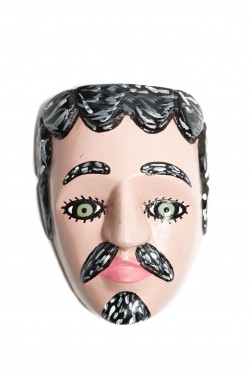 “Persona” is a term that’s gotten very popular in marketing in the last few years. In ancient Latin, the word meant “mask.” It may have evolved from the Etruscan personare (“to sound through”), which referring to the theatrical wooden mask in which the mouth was made to strengthen the sound of the voice.” In literature and the theatre in the last century, the word came to express the concept of a “literary character representing voice of the author.”In Jungian psychology, it’s used to denote the social mask one shows the world. And it’s also a film by Ingmar Bergman. Words such as “personality”, “personify”, and “personal” all stem from the same roots.
“Persona” is a term that’s gotten very popular in marketing in the last few years. In ancient Latin, the word meant “mask.” It may have evolved from the Etruscan personare (“to sound through”), which referring to the theatrical wooden mask in which the mouth was made to strengthen the sound of the voice.” In literature and the theatre in the last century, the word came to express the concept of a “literary character representing voice of the author.”In Jungian psychology, it’s used to denote the social mask one shows the world. And it’s also a film by Ingmar Bergman. Words such as “personality”, “personify”, and “personal” all stem from the same roots.
In our marketing world, the concept of a “buyer persona” is the practice of distilling a group of people into a single essential  representation with an identifiable pattern of assets, attributes, and activities. The idea is to determine who is most likely to find your products or services desirable, and then to focus on marketing to them, using their common characteristics to guide your efforts.
representation with an identifiable pattern of assets, attributes, and activities. The idea is to determine who is most likely to find your products or services desirable, and then to focus on marketing to them, using their common characteristics to guide your efforts.
This has always been a good idea; media buyers have long made a science of figuring out where to place advertising so that it’s most likely to be exposed to proven potential buyers. Some years ago I sold newspaper advertising in a mid-sized blue-collar town. A little research showed that demographically speaking, the citizens were less likely have college educations, more likely to have done military service, more likely to have larger families, more likely to enjoy outdoor pursuits such as fishing and hunting … and more likely to buy used vehicles. When I shared this data with car dealerships in my territory, they began advertising to that demographic, and the result was higher sales. Everyone was satisfied.
As buyers moved online, it became possible to identify more traits and characteristics that gave valuable clues to who those people were and what they cared about, and marketers began refining demographic, firmographic, and psychographic profiling to include more of these factors. The pictures that began to develop had more depth and nuance, and went beyond a target demographic to more personalized … personas. The result can be marketing that feels to a prospect as though the marketer is paying attention to them and understands them at least a little. It can be the beginning of a mutually satisfying relationship.
Creating personas may sound complicated, but it doesn’t need to be. You can look to your own customers to help you, and take this proven series of seven steps:
Look at the data to determine your best customers
Begin the process by looking at data that represents your current customers. Try to find the customer segments that are the most valuable to you by looking at revenue, gross margin, sales cycle length, customer lifecycle, and so on. Look for your most profitable customers.
 Look for common traits among your best customers
Look for common traits among your best customers
Analyze the list of best customers by searching for common traits: company size, location, the buyer’s role, industry, existing technology, and possibly problems faced are all examples of potential common characteristics. As an example, one of Act-On’s’ customers analyzed their own data and discovered that most of their best customers were companies of a certain size using a particular CRM technology. Knowing this let them tailor marketing approaches to this specific group.
Meet with individual sales reps to get anecdotal feedback on the data
Nobody has better information than your own people on the front lines. The most successful salespeople have an instinct for whom to focus on. Talk to them, and let those conversations refine the initial profile of the target buyer that you gathered from data. Plus: Sales has to buy in to the personas you create in order to trust the leads that result from the process, so get their input early and often.
Determine whether marketing can/should target a persona
You might have nailed the absolute killer persona, but what if there are only 200 of them? If you’re selling a very big-ticket item and your goal is ten sales a year, maybe a target of 200 is enough. But that’s not the case for most of us. Before finalizing personas, make sure you’ve agreed on a profile that fits a large enough group to be worth your time to market to – and that can be reached with the marketing capabilities you already have.
 Map the buying process of your target buyer personas
Map the buying process of your target buyer personas
Talk to your sales reps and your existing best customers. Analyze your online tracking data, and the patterns of interaction and engagement with your assets. Outline the steps the good buyer takes from the status quo until they purchase your product. This insight into the buying process will allow you to create highly effective sales and marketing messaging, programs, and processes. For example, many companies create content for each stage in the buying process to first attract the buyer, then to help the buyer move to the next stage in their process, with additional content for the final decision-making stage.
Publish the target buyer personas internally
Once the target buyer personas, journey, and attendant messaging are agreed upon, you need to distribute this information to sales and marketing to ensure that everyone is targeting the same buyers. This also keeps communication channels open so that when new patterns emerge, you’re more likely to hear about them.
Some companies go as far as to give each persona a name and a backstory and create a picture or drawing of each one. Do whatever it takes to help people adapt to using personas. Your creative team in particular – the ones creating email messages, infographics, writing web copy and white papers, particularly need to understand who they are writing for.
 Optimize the target buyer persona definitions quarterly
Optimize the target buyer persona definitions quarterly
Each quarter, sales and marketing should evaluate the current buyer personas by reviewing data and anecdotal feedback to determine effective they still are. The market is dynamic; your personas will change over time.
Check out Jay Hidalgo’s recent blog post, Bootstrap Buyer Persona Building in 4 Steps, for a handy matrix that will help you build personas.
